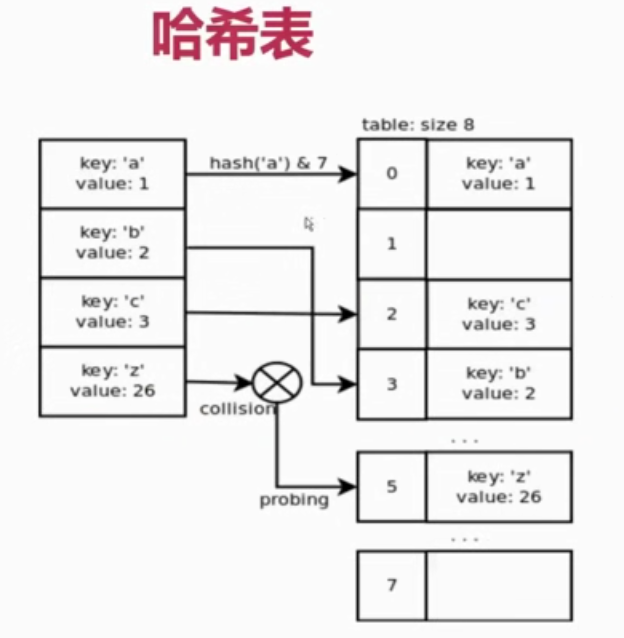一、深入python的set和dict
1.1、dict的abc继承关系
from collections.abc import Mapping,MutableMapping #dict属于mapping类型 a = {} #字典a不是继承MutableMapping,而是实现了MutableMapping的魔法函数 print(isinstance(a,MutableMapping)) #True
1.2、dict的常用方法
a = {"lishuntao":{"company":"hut"},
"lishuntao1":{"company":"hut1"}
}
#clear
# a.clear()
# print(a) #{}
#copy,返回浅拷贝
# new_dict = a.copy()
# new_dict["lishuntao"]["company"] = "HUT" #new_dict拷贝出"lishuntao"与"lishuntao1"这是浅拷贝,
# # 第二层的dict也就是数据结构没有被拷贝出来,因此值会变动。
# print(new_dict) #{'lishuntao': {'company': 'HUT'}, 'lishuntao1': {'company': 'hut1'}}
# print(a) #{'lishuntao': {'company': 'HUT'}, 'lishuntao1': {'company': 'hut1'}}
#深拷贝
import copy
new_dict = copy.deepcopy(a)
new_dict["lishuntao"]["company"] = "HUT"
print(a) #{'lishuntao': {'company': 'hut'}, 'lishuntao1': {'company': 'hut1'}}
print(new_dict) #{'lishuntao': {'company': 'HUT'}, 'lishuntao1': {'company': 'hut1'}}
#fromkeys 将可迭代的对象转换为dict
new_list = ["li","li1","li2"]
new_dict = dict.fromkeys(new_list,{"company":"hut"})
print(new_dict) #{'li': {'company': 'hut'}, 'li1': {'company': 'hut'}, 'li2': {'company': 'hut'}}
#get #如果没有这个键不会抛异常
value = a.get("lishuntao111",{})
print(value) #{}
#items()
for key,value in a.items():
print(key,value) #lishuntao {'company': 'hut'},lishuntao1 {'company': 'hut1'}
#setdefault
new_dict = a.setdefault("litao","hugongda")
print(new_dict) #hugongda
print(a) #{'lishuntao': {'company': 'hut'}, 'lishuntao1': {'company': 'hut1'}, 'litao': 'hugongda'}
#update #可迭代的对象
#a.update([("lishun","tao"),("li110","hu")])
a.update(lishun='tao',li110="hu")#一样的效果
1.3、dict的子类
# #不建议继承dict和list # class Mydict(dict): # def __setitem__(self, key, value): # super(Mydict, self).__setitem__(key,value*2) # # my_dict = Mydict(one=1) # print(my_dict) #{'one': 1} # my_dict["one"] = 1 #{'one': 2} # print(my_dict) # """ # 在某些情况下,用C语言写出来的python内置类型,它不会调用__setitem__方法 # 因此我们想要继承dict的话,就去继承UserDict(例如下面) # """ from collections import UserDict # # # class Mydict1(UserDict): # def __setitem__(self, key, value): # super(Mydict1, self).__setitem__(key,value*2) # # my_dict = Mydict1(one=1) # print(my_dict) #{'one': 2} # my_dict["one"] = 1 #{'one': 2} # print(my_dict) from collections import defaultdict """ defaultdict重写了__missing__方法 """ my_dict = defaultdict(dict) my_value = my_dict["lishun"] #按照正常情况会报错误 print(my_value) #{} my_dict1 = {} my_value1 = my_dict1["lishun"] print(my_value1) #KeyError: 'lishun'
1.4、set和frozenset
#set 集合 frozenset 不可变集合 无序、不重复 s = set("abcde") s.add("u") print(s)#{'b', 'a', 'e', 'd', 'c', 'u'} s2 = frozenset("abcdef") #frozenset 可以作为dict的key print(s2) #frozenset({'b', 'f', 'a', 'e', 'd', 'c'}) #不能修改 #difference anoth_set = set("cdefgh") res = s.difference(anoth_set) print(res) #{'a', 'b', 'u'} #集合运算 交 并 差集 res = s - anoth_set res1 = s & anoth_set #交 res2 = s | anoth_set #并 #set性能高 #实现__contains__魔法函数就可以做if判断
1.5、dict和set的实现原理
dict和list查找元素,dict查找的性能远远大于list,在list中随着list数据的增大查找时间增大,在dict中查找元素不会随着数据的增大而增大,dict的实现原理叫做哈希表。哈希表的存储逻辑,哈希表的右边是数值的存储结构,是连续的数组,这个数组里存了指向key和value的指针。


哈希表的查找:首先计算dict的键的hash值,然后利用hash值定位数组中的一个表元,此时判断表元是否为空,如果表元为空,直接抛出KeyError,如果表元不为空,则判断键是否相等,如果相等的话返回表元里的值,如果不相等的话,则使用hash值的另一部分来定位hash表的另一行,然后又判断表元是否为空进入下一次判断循环。
特性:
1、dict的key或者set的值都必须是可以hash的(不可变对象,都是可以hash的,str,frozenset,tuple,自己实现的类__hash__都是可以hash的)
2、dict的内存花销大,但是查询速度快,自定义的对象或者python内部的对象都是用dict包装的
3、dict的存储顺序和元素添加顺序有关
4、添加数据有可能改变已有的数据的顺序